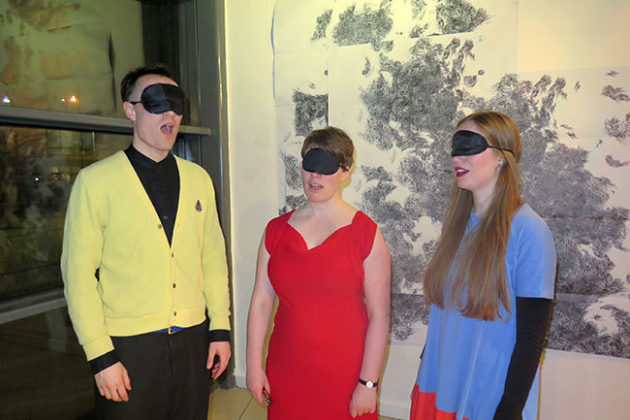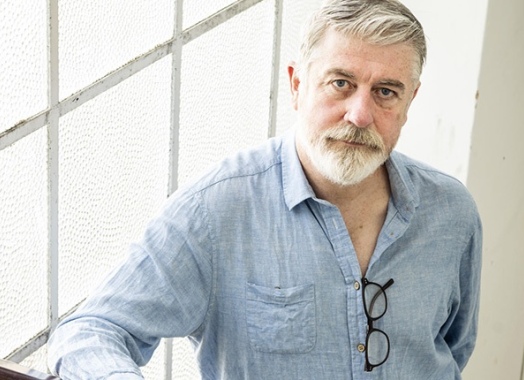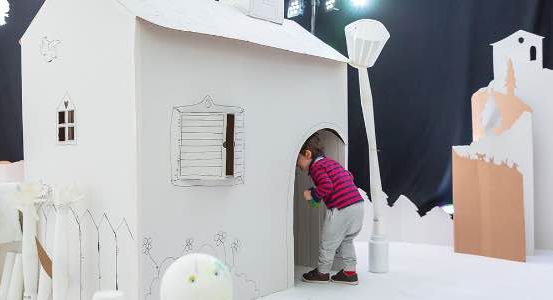
Des Kenny Reviews PLATFORM 18

The opening night for the exhibition PLATFORM 18 at Draíocht was a well attended event with artists and their supporters jostling for space amidst the cornered artworks. It took a number of calls from Emer Mc Gowan, Director of Draíocht to gather the audience attention and announce that three performance works were about to commence.

Dancers: Cian Coady and Mia DiChiaro / Photographer: Misha Beglin
The first piece in the programme demanded the audience to free a rectangular space marked with tape on the gallery floor. Two young dancers, Cian Coady and Mia DiChiaro, occupied the taped area and guided by the slow pulsating beat of a metronome, their initial static bodies dissolved into blurring movement, conveying the emotion of youthful relationships through dance, in 'Distrupting the Flow'. The young boy placed his insistent hand on her shoulder but she dislodged his misguided approach disdainfully and swirls away out of reach. Undaunted and trying to make a connection once again, the male dancer mirrored the female dancer’s movements across the floor. Failing in his attempts at romantic courtship, he increases the frequency of the metronome and his angular gestures unbalance the passionate tension between the dancers. Stopping the metronome and resetting it to a slower pace, the female dancer weaves control and she gradually allows the young man to place his love melted hand on her shoulder while her sinuous neck caressed his hollowed breast.

Mark Buckeridge uniquely combines the disciplines of painting and song to explore the transient nature of secular existence. On the opening night he created a musical performance with the aid of a small electronic piano and digitally recorded background rhythm. His voice complimented the urgent pulsing cords of the electronic piano and the unrelenting tempo of the digital base line. The lyrics colour the tonal phrases of the piano with prickling passion as the artists voice emphasises the tenor of the song. The phrase “All I want to do is cry” is repeated with various changes of anxious cord modulations creating a note of melancholy to the performance. A sense of resolve is discovered when romantic despair allows a song be born from the artists pen. His anxiety is tempered by the songwriter’s craft that permits him to sing triumphantly the words “Hand crafted with love and joy”. His two paintings in the show use a variety of materials that present an unrepressed desire to allow calligraphic marks find the surface of the canvas intuitively, unhindered by cogitative processes. In ‘Riff’, a swirling mark of silver spray is surrounded by a black paint that does not suffocate the image but allows it breath like an opening guitar riff of a song. ‘Autograph’ is an all-white canvas bestowed with gyrating black marks with a hastily pasted transparent plastic sheet superimposed on the canvas. The unbridled mark making are secured in the composition by the engaging trompe l'oeil intervention of the clear plastic material.
Robbie Blake, Elizabeth Hilliard and Julie Shanley, three members of Tonnta vocal ensemble, presented a performance of a work called ”A Signalling”. Each wore a blindfold and earplugs isolating themselves from each other and the audience. Disengaged from the senses they began to sing songs which had a personal relevance to their lives. The performance fragmented into a loose arrangement of songs and the arbitrary interchange dismisses a shared narrative. The emotional attachment the singers instilled in their song, remained inaccessible to the other performers. It was only when the singers began to vocalise accapella and words had no relevance to the recital, that they became a unified force. Language builds walls but music opens doors and the singers suddenly began to communicate with the audience and themselves. They were no longer three separate elements exploring individual concerns but an inclusive unit, emotionally connected by music. When the three minute performance ended there was a spellbound silence like the hushed quiet of fallen snow, before the attentive audience applauded. Music needs silence to give it structure and the audience participated to this end because the music ensnared their willing attention.
Emma Brennan installs three small video monitors on the floor depicting the artist attempts to move an amorphous mass of sticky dough across the gallery. The doughy substance corresponds to the artist’s body weight and no doubt relates to societies obsessive desire to ceaselessly record our weight daily. If we are above our correct body mass index, as denoted by weight, the unconscious impact of how we internally visualise the way we are perceived externally, can lead to personnel revulsion and psychological disorders. The physical demands in moving this loquacious mass leaves the artist breathless as she endeavours to propel it across the gallery space. The action moves slowly from screen to screen as meaningless progress of the uncrumpling task is inscrutably recorded. The artist receives no break unlike the mythical character Sisyphus who gained respite after he propelled the punishing stone to the summit of his mountain and watched it roll unaided to its origin. There are no receding slopes to help ease this absurd undertaking or a finish line to end the fruitless journey. The performer tragically becomes imprisoned in an unending labyrinth of absurdity while attempting to portray meaning in a meaningless world. The end product is a work of art which is inherently gripped by its own insular logic.

Artist: Eve O Callaghan / Photographer: Misha Beglin
Eve O Callaghan’s two large elegant paintings convey, through the formal language of minimal abstraction, a restrained emotional atmosphere that challenges the viewer to find understanding in art by paint alone. In ‘Word’, the woven paint surface both reflects and absorbs light, oscillating the vibrancy of the hues across the receptive fabric. A large section of the canvas is covered in scrumbled blue, painted sparingly over black under-painting, which bleeds out to the insistent edge of a yellow border. The muted magnetic blue soaks up the gallery light, forming a subterranean realm beneath the exterior skin of paint. A glistening green stripe, that tops the painting, pushes forward perceptively and acts as a counterweight in opposition to the receding gesture of the blue. The push pull retinal after-image caused by the paint gives an illusory sensation of movement.
In ‘Copy’, a large area of untreated canvas acts as a secondary colour to the painted sections of orange and black. The orange expanse of colour is warm and effervescent, while the black is cool and reductive. The orange and black do not touch but are separated by a thin line of unaffected raw canvas. The black’s natural dominance over other colours is undermined by the removal of thin strips and the abbreviated rectangle form lacks completion. Truncated and unbalanced, the black is held in check by the light affirming orange. The phlegmatic visual language deployed by the artist cannot contain the vibrancy of these paintings.
Ella Bertilsson and Ulla Juske collaborate to make art and their exhibit is based on a residency they had in Draíocht’s Artist Studio. They placed a large pile of A4 sheets of paper, filled with short informative sentences, on a plinth, encouraging members of the public to remove them as they wish. The paper stack is constantly replenished like a shelf in a supermarket that must never appear empty. The relentless demand to renew the stockpile introduces an element of consumerism to the artwork reflecting on societies all-consuming appetite for material things. The title of the work ‘Back And Forth There And Back’, reveals short pieces of random data that are concerned with the science of cosmology, intermingled with aimless indiscriminate observations on daily life around the of area Dublin 15. Yet the work reads like a long poem that has an inherent logic and rhythm that even its apparent chaotic formulation cannot unwind.
The Gum Collective are an eclectic group of artists who specialise in printmaking, yet maintain a broad based practice dipping with ease into various visual art disciplines.
Ciaran Gallen presents a digital video of a super hero character floating above a city in a riot of synthetic colour hypnotically mesmerizing the viewer. Head phones are supplied and vibrating sonic rhythms blend seamlessly with the imagery on the video screen. The punchy vibrancy of the screen theatrics are held in check by the haptic intervention of black plastic mesh, which hovers like a web between viewer and screen. This added sculptural presentation creates a visual dilemma for the audience, when looking at the screen action the mesh dissolves before the eye; while staring at the mesh the video monitor becomes obscured and out of focus. The foreground and background oscillate constantly creating a retinal aftershock for the viewer, which although disturbing has a striking effect.
Stephen Lau and Aaron Smyth offer a unique framework for their art pieces. Four large planks of wood are fastened from the gallery balcony and reach the floor of the main gallery. Stephan hangs a humorously shaped sculpture from a chain with glass baubles dangling above four super hero figurines. There is a playful characteristic to the installation, as strange bulging forms protrude from the sculpture that hangs like a mother-ship above the plastic figures. The return by artists to childhood themes offers a transgressive posture against the current trends in contemporary art. Reaching back to childhood where creativity began, allows the artist find forms, unclouded by art history which have a uniquely individual and formal presence. The artist understands this and makes juvenile artefacts that use humour and wit to undermine the solemnity of conventional art practice.
Aaron Smyth encloses his double sided drawings behind glass between wooden planks suspended from the upper balcony. A finally executed drawing in red chalk of a man and woman are explored in a fractured fashion giving an insight into a deteriorating relationship. Shared recollections of their affair splinter across the surface of the drawing as a gentle hand lifting an arm dissolves into sharp edges and unfurling bed sheets. Relationships fall apart but knotted memories cling on inside to create a forlorn replica of the irretrievable. Another drawing is positioned on the reverse side of the hanging frame. A naked man tethered to emptiness floats in an indefinable space beneath another displaced figure which dissolves in throbbing flumes of mist. Unreconciled the two figures drift apart into the dismembered shadow land of drained desire.

Artists: Alex DeRoeck & Ciara O'Brien / Photographer: Misha Beglin
Alex DeRoeck’s sculpture stands emphatically on an aluminium base where ‘no dogs allowed’ signs are fixed triumphantly to the pedestal. A humorous dog like creature with a cigarette protruding from a muzzle hangs on a leash affixed to the sculpture waiting obediently for its master’s instructions. The sculptural structure is roughly covered in black acrylic filler where a female superhero figure emerges from the shadows. The sculpture recalls comic book imagery of tortured super heroes whose all too human flaws far outweigh their powers. This quixotic effigy recalls these fallen super heroes as they prepare to overcome trials in a random dystopian future.

Artist: Sofya Mikhaylova / Photographer: Misha Beglin
Sofya Mikhaylova’s sculptural work sits delicately on the gallery floor. Enclosed in meshed wire and bordered by red felt are fragile drawings in charcoal of female figures. The illustrations are drawn on cut out pieces of white felt with a red trim of enclosing thread. The feminine forms at times seem hemmed in by the red trimming, restricted in their space and are unable to move freely. The cut felt pieces shrink the figures environment and become a vehicle for imprisonment. It is a sober ephemeral work, exploring the lingering legacy of gender imbalance in contemporary life.
Ciara O’Brien displays large-format digital prints of clouds, placed like playing cards on top of each other and gives an illusion of depth, while paradoxically maintaining the hard-edged primacy of the printed surface. The pixelated clouds surge and float creating illusory movement while displaying stillness. The retinal focus shifts constantly across the prints surface, as the semblance of motion is embedded in the viewer’s imagination. The artist examines how we readily accept visual information that is false and misleading, implying that our brain is hard-wired to betray us.
Aimee Gallagher employs digitalised photos and screen prints to cover a section of the gallery wall with the depiction of a mountain range. The silhouette edge of anonymous mountain peaks stand out sharply defined against the stark white gallery walls. Floating architectural forms protrude from the sky above the mountains like UFO’s, creating a sense of unease as the relationship between mountains and the hovering architecture is ambiguous. The arrested definitions of the work permit multiple interpretations allowing the viewer freedom to decipher its enigma.
Sadbh O’Brian’s Lacuna is made of white plastic material whose bulbous appearance is slotted with holes. Some cavities are filled with collaged imagery from magazines, that glossily portray the female form utilised as a means of product promotion in advertising. Bare legs with a flower beside seductive lips incorporate a quote “We are talking about the body of the beloved, not real estate“, which is attributed to Terry Tempest Williams, an environmental and social campaigner. The artist is reacting against the prevailing trend in advertising to commodify the female body for commercial reasons and isolating it from the artistic desire to represent the female form as a transcendental exploration of beauty. Beneath the white PVC sculpture is a moulded boxing glove tethered to cloth chains humorously implying there is a fight-back against the misrepresentation of women to sell merchandise. Art is always at the forefront of change in society.
Landing Collective is the name of a project devised by the Dancer Aliina Lindroos and visual artist Moran Been-noon. They investigate through the medium of dance and video, social themes of alienation, displacement and our deeply driven impulse to create a home. The video called ‘Can You hear The Birds from the Water’, displayed on double screen monitors, captures the shifting ground between water and land, where the initial contact for a new beginning is initiated for fleeing migrants. This fluid hinterland on the edge of flight and freedom precariously lures the protagonist to believe that hope lies just beyond the watery border. The screen shows feet pushing forward through the guarded shallows, searching for dry land as loud sonic booms pommel the air with foreboding. The expansive water seems unending and dry land elusive. Another screen displays black and white imagery of a young woman suspended over coloured imagery, which slip and collide as the protagonist blindly aspires for a new life. The performer is marginalised on the interface of a traumatic past and an uncertain future, unable to move beyond the waters threshold by unseen forces.

Artist: Louis Haugh / Photographer: Misha Beglin
Louis Haugh is a photographer and his large multi-faceted photograph dominates the largest gallery wall in the Ground Floor Gallery. The bleak landscape of a denuded forest arches upwards to a choked grey skyline and the scarred scrubland is all that is left of a forest felled as a crop leaving the terrain ruined and abandoned. The shrouded image is formed, by the grouping in a rectangle, of seventy photographs, inscrutably pinned by nails to the gallery wall. Each photograph curling at the edges tries to remove itself from its restraints like a butterfly attempting to escape the stabbing pin of a lepidopterist. The photograph is ready to crumple and tear and uniquely resembles the blotted landscape it portrays. The photograph and landscape mutually share the same ravished fate.
Participating artists: Ella Bertilsson & Ulla Juske, Robbie Blake, Emma Brennan, Mark Buckeridge, Cian Coady & Jessica Kelly Hannon, Gum Collective (Aaron Smyth, Alex de Roeck, Aimee Gallagher, Ciara O’Brien, Ciaran Gallen, Sadbh O’Brien, Sofya Mikhaylova, Stephen Lau), Sarah Farrell, Lisa Freeman with members of Dublin Youth Dance Company, Louis Haugh, Landing Collective (Aliina Lindroos & Moran Been-noon), Eve O’Callaghan.
Curated by Sharon Murphy.
Desmond Kenny is an artist based in Hartstown, Dublin 15. He is a self taught painter, since he began making art in 1986 he has since exhibited widely in Ireland and abroad, solo shows include Draíocht in 2001, The Lab in 2006 and Pallas Contemporary Projects in 2008. His work is included in many collections including the Office of Public Works, SIPTU, and Fingal County Council. Kenny's practice also incorporates print making and he has been a member of Graphic Studio Dublin since 2004.
Discover More View all


Artist Support | Tobi Bello - Ethical Framework Development
Ethical Framework Development

Nicole Manning - Instagram Takeover
August 2025

Artist Studio Residency Announced: James McLoughlin
Visual Artist’s Studio Award
September-December 2025
